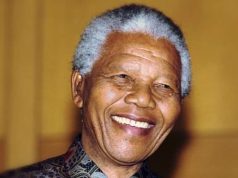JUNE 11- South Africans prayed for Nelson Mandela’s recovery on Sunday as the 94-year-old former president spent a second day in hospital with a recurring lung infection.
Mandela, a global symbol of triumph over adversity and of reconciliation who became South Africa’s first black leader in 1994 after the defeat of apartheid, was hospitalised early on Saturday when his already frail health worsened.


It is his fourth hospital stay since December and the government said on Saturday his condition was “serious”. During previous hospital visits it had highlighted his “good spirits”.
The government had yet to give an update by Sunday afternoon, stoking concern on social media and among the millions of South Africans who revere Mandela for his decades of struggle against white-minority rule and for steering the continent’s biggest economy to all-race elections.
Presidency spokesman Mac Maharaj said he would issue a statement about Mandela’s health if doctors gave him any information. Maharaj had said on Saturday Mandela was breathing on his own, calling that a “positive sign”.
Hundreds gathered to pray for Mandela at Sunday Mass at the Regina Mundi Catholic church in the sprawling Johannesburg township of Soweto.
“We wish him speedy recovery, he must get well,” Soweto resident Mlugisi Sekhosana said. “We know what he did for us in South Africa. All the nation, black and white, we wish him well.”
The Sunday Times newspaper took a sombre tone, with the headline “It’s time to let him go”, quoting a longtime friend of Mandela’s, Andrew Mlangeni.
“The family must release him so that God may have his own way. They must release him spiritually and put their faith in the hands of God,” the newspaper quoted Mlangeni as saying.
“Once the family releases him, the people of South Africa will follow.”
History of lung problems
Mandela has a history of lung problems dating back to his time on the wind-swept Robben Island prison camp near Cape Town.
Before his 1990 release he spent nearly three decades in prison for conspiring to overthrow the apartheid government.
He stepped down as president in 1999 after one term in office and has been removed from politics for a decade. His last appearance in public was at the final of the soccer World Cup in Johannesburg in 2010.
He spent nearly three weeks in hospital in December with a lung infection and after surgery to remove gallstones.
A growing phalanx of international and local media assembled in front of the Mediclinic Heart Hospital in the capital Pretoria, where Mandela was believed to be staying.
Mandela’s wife, Graca Machel, had accompanied him to the hospital on Saturday, the South African Press Association reported. She had cancelled a speaking engagement in London.
Social media platform Twitter was alight with comments from well-wishers in South Africa and across the world, with many commenting on the government’s silence and Mandela’s legacy.
“I hope God grants me years to tell my grandchildren about Nelson Mandela, the pride of Africa, the prisoner who freed his jailers,” said one Twitter user.Former South African President Nelson Mandela was taken to a hospital on Saturday to be treated for a recurrence of a lung infection and is in “serious but stable” condition, the president’s office said.
The anti-apartheid leader, who is 94, has received hospital treatment several times in recent months. His health has been failing in recent years.
“During the past few days, former President Nelson Mandela has had a recurrence of lung infection,” said the statement from the office of President Jacob Zuma. “This morning at about 1.30a.m., his condition deteriorated and he was transferred to a Pretoria hospital.”
It said Mandela was receiving expert medical care and “doctors are doing everything possible to make him better and comfortable.”
Zuma wished Mandela a quick recovery on behalf of the government and the nation and requested that the media and the public respect the privacy of the former leader and his family, the statement said.
Mandela’s forgiving spirit and belief in racial reconciliation helped hold South Africa together at a time of extreme tension in the run up to elections in 1994. The Nobel Peace Prize laureate, who was imprisoned for 27 years by the racist white regime, became the first democratically elected president of South Africa in that year.










